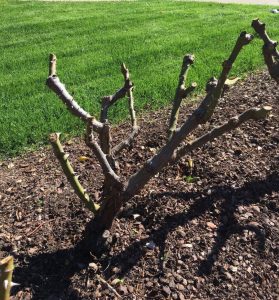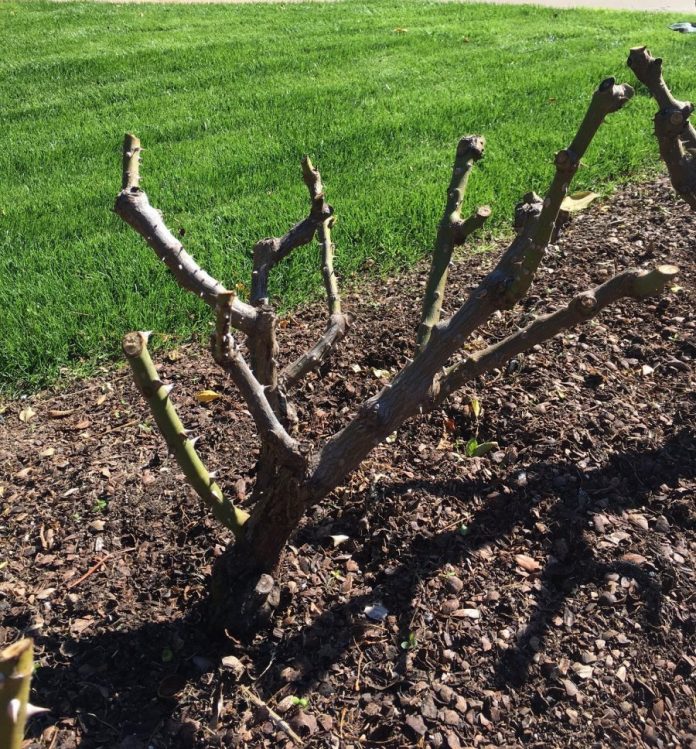 By Sharrie Ely, DCMGA Rose Rosette Disease Team
By Sharrie Ely, DCMGA Rose Rosette Disease Team
February has North Texas gardeners preparing their roses for spring. February 14 is the traditional time for our area to start rose pruning. A few weeks after their February pruning, rose bushes will start putting out the new growth that shows us spring is here and beautiful roses will soon follow.
Pruning roses may sound a bit intimidating to the uninitiated, but it really is an easy process. Roses in the landscape are tough plants and can take quite a trim. Just as all gardeners do not garden in exactly the same manner, all rose growers do not prune in exactly the same way. The basics techniques are important but really, you can’t go wrong. Don’t be afraid to tackle this garden task. This garden chore will encourage new growth and blooms, clear out any dead wood, and shape the plant so it will look lovely in your garden.
Let’s check the list of tools needed and get ready to tackle this project. You will need by-pass hand pruners, a long- handle lopper, and hedge clippers. Yes, hedge clippers. Before starting make sure your tools are clean and sharpened. Also, don’t forget that you will need heavy-duty garden gloves and arm protection.
As you prune you will need to clean your tools from one shrub to the next to prevent the spread of some rose diseases. Ammonia-based wet wipes are good to use. It is not recommended to use bleach or bleach wipes to clean your tools as bleach can be corrosive.
Start the pruning process by assessing the shape of your rose. Is it mostly shrubby? Or is it tall and with more of a lanky growth? Is it a climbing rose? If it is a shrubby rose, use the hedge clippers and reduce the rose by 30 to 50%.
In thinking how much you need to prune, consider your garden. In a smaller, urban garden, you may need to keep your roses smaller so you can reduce them by 50%. If size is not an issue, you may choose to reduce your shrubs by only by 30%. Both shrubs will increase in size as they put on leaves and buds in the spring.
After cutting the shrub, use your hand pruners to remove dead canes, longer, thin canes (less than a pencil’s width), and canes that are crisscrossing or touching another cane. Make sure your tools are sharp and make clean cuts. Remove extra canes from the center of the shrub by cutting them all the way to the ground. This will open up the center of the shrub for good air-circulation. Leave up to four or five canes. Shape the remaining shrub with your hand pruners. You can prune these remaining canes at a 45-degree angle, a ¼ inch above an outward-facing bud but in shrub roses it does not make much of a difference.
The pruning process for a taller and lankier rose is very similar to a shrub rose. There are fewer canes to prune so start with loppers to remove dead canes, pencil-thin canes, and canes that are touching. Leave three or four canes. Trim them up to 30 – 50%. Because this variety has fewer canes it is easier to cut these at a 45-degree angle, ¼ inch above an outward-facing bud. Because the bud is “outward-facing” the cane will grow outward and leave the center of the rose open for air circulation.
Pruning climbing roses is different than pruning other varieties of roses. Start by removing the dead wood. Pick the long canes that you wish to keep, any number from four to six. The number you keep depends on the size of the garden area.
Remove extra canes so the remaining canes can grow unhindered. Do not shorten the long canes as this variety will produce spring blooms laterally along a horizontal cane. When trained upright on a fence or structure, you will only have blooms produced on the ends of the canes. Tie these canes horizontally on a structure such as a fence and you will see blooms along the long cane.
While pruning your roses, if you come across an abnormal, bunched up growth, your rose may be infected with Rose Rosette Disease. RRD is caused by a virus. This virus has been in the United States since the 1940s but in the last few years it has become prolific in the North Texas area. At this time, there is no cure. Instead of pruning out the mutated growth, you should remove the entire rose, roots and all. This virus is spread by an eriophyid mite, a tiny arthropod that can crawl from rose to rose. Cut and bag the rose to dispose of it. Do not drag the infected plant through your garden.
After you have finished pruning your roses there are two optional tasks. These include stripping the leaves and applying a horticulture oil. A busy gardener may run out of time to do these two steps. Not all rose gardeners apply horticulture oil or strip the leaves but the choice is yours.
Finally, remove rose leaves and debris from the garden and apply the fertilizer of your choice. This is an important step that will give your roses the added boost for spring blooms. Fertilizing is the final step of pruning and prepping your roses.
Spring is coming and if you take the time now to do these rose pruning tasks, you will soon see the rewards in the blooms to come.
For more information on this and other gardening topics, visit the Denton County Master Gardeners Association website at dcmga.com; submit questions to our free help desk; and subscribe to our monthly newsletter “The Root” at https://dcmga.com/home/join-the-dcmga-email-list/.




.jpg)









